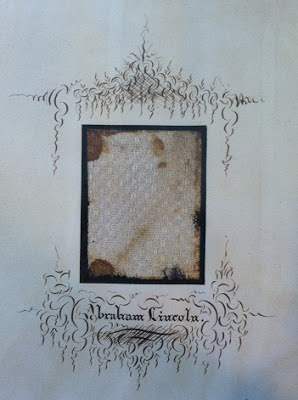 |
| Head-and-shoulders portrait of President Abraham Lincoln, traditionally called "last photograph of Lincoln from life." Image from the Library of Congress (www.loc.gov). |
This blog entry is written by volunteer Hannah Hamilton.
He was a physical marvel of his
time, and remains an intellectual wonder for all mankind. He, more so than any
other president, embodied what many consider to be the American Ideal. Born on
a bed of bearskins which hung from the wall by leather straps, receiving only
one year of schooling before educating himself through toil of mind and body,
he rose to be the man who would ultimately abolish American slavery and
preserve the Union. He was “The Giant of the West,” a living paradox in his own
right, and his tale has become the stuff of legends.
“It is near midnight, and I have just come in from seeing enacted a
tragedy which will ring down through the ages ‘Till time shall be no more,’ the
assassination at Ford’s Theater of Abraham Lincoln, the president of the United
States.” –Captain Charles Lewis of Schenectady, NY; April 14, 1865
 |
| A Mathew Brady photograph of Lewis taken in Washington on August 7, 1863. Photo from the collections of the Efner City History Center in Schenectady. |
Captain Lewis, the son of Taylor
Lewis (one of Union College’s earliest professors), was one of at least two
Schenectadians present at Ford’s Theater the night of Lincoln’s assassination.
In Lewis’ diary, held at the Efner City History Center along with numerous contemporary
documents, he recounts the horror and excitement of that tragic night.
Lincoln’s death came four short days after the end of the Civil War, and
blackened a time of celebratory elation in Washington D.C. and the North.
Lewis’ journal provides modern scholars with a firsthand look at the immediate
impact of Lincoln’s death, and is especially special to a Schenectadian
audience.
Lincoln visited Schenectady
twice, the first time following his election as president in February of 1861.
Though Lincoln had lost the city of Schenectady in the 1860 election by 33
votes, he was met by an enthusiastic crowd as his train rolled across Union
Street five minutes ahead of time. The journey was not a pleasant one for the
president, who was described as looking exhausted and frail.
With rumors of assassination and
secession already circulating, it was much to the alarm of everyone aboard the Ernestus Corning when the reverberation
of a celebratory cannon welcoming the president blasted out several of the
train’s windows. Despite the warm welcome which met him on the rundown
Schenectady streets, Lincoln refused to leave the train and take the platform
erected for him, because he had refused to do so in other towns. Instead, from
the back of the train, he announced to the crowd that he had, “no speech to
make, no time to make one and not sufficient strength to make one if [he] so
desired,” according to Robert Freeman, the engineer at throttle on the Ernestus
Corning.
 |
| A 20th century artist’s depiction of Lincoln’s 1861 visit to Schenectady. Located in Lincoln, Abraham In Schenectady clipping file, Grems-Doolittle Library. |
President Abraham Lincoln
visited Schenectady for the second time in 1865, and this second time, just
like the first, he did not leave the train. The funeral train of the president
passed through Schenectady piloted by the city’s own Alonzo J. Wemple, born
October 1st 1833. Wemple, who served as a railroad engineer for
several decades, “recalled feeling pity for the Confederate prisoners of war
who were loaded into boxcars and shipped to prison camps in the North.” It was
with great pride that he joined the elite team of engineers who piloted the
funeral train of Abraham Lincoln, and drove the train as it passed through the
city of silent onlookers in 1865.


No comments:
Post a Comment